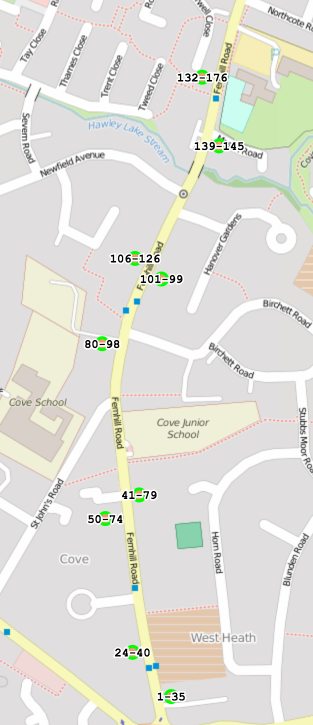Archive
Adding house numbers to Open Street Map
Team OSM-house-numbers (Pavel and yours truly) was at the Open Street Map London hack weekend a few days ago.
When Phyllis Pearsall was out walking the streets of London in the 1930s gathering information for her Geographer’s A-Z London street map she recorded house numbers and included this information on her maps. House number information is included in OSM data when people have added it. Is there a way of automatically adding this information in bulk?
The UK Land Registry maintains a database of house sales; the information includes postcode, street and house number. The database is available under the Open Government License, which is compatible with the OSM license.
It is straight-forward to match all house sales having the same postcode/street to obtain a min/max house number for a postcode/street.
The first half of a UK postcode specifies a large area or district (e.g., GU14 is my district code), while the second half has a granularity of around a quarter of a mile or less (depending on housing density).
It was decided that house numbers on a map become useful when streets are long enough, where long enough is defined as containing houses having different postcodes. Assuming that street names are unique within a given postcode district, filtering out not-long enough streets was trivial.
The Land registry started recording sales in 1995 and it is possible that some streets are not considered to be long enough because they contain houses that have not been sold within the last 20 years; this problem will also affect the min/max value of some house number ranges.
To tie this postcode/street information to Open Street Map data we need latitude/longitude information.
Information on house number locations is very useful to governments and in the UK is collected by our national mapping body, the Ordinance Survey, who like all UK government bodies have a long history of being loath to make information available for general public use. The current situation, according to Wikipedia, is that the Ordinance Survey mapping from postcode to latitude/longitude is available as open data.
Adding information for postcode lat/long and feeding everything into a webpage produces a map such as the one below (opposite sides of the street having different postcodes is plainly visible):

We cannot guarantee that the house number data we have created is 100% accurate; there may be mistakes in our code or the Land registry/Ordinance Survey data we processed. Experienced OSM hackers at the event told us about minor mistakes in automatically generated data, that had occurred in the past and had a disproportionate impact on user confidence in OSM accuracy. So we did not upload our data to OSM; you can find it on github (saved in compressed form to reduce download time), along with the code used to create it.
The hackathon finished at five, with people decamping to a local pub. We were more or less done by three. What next (perhaps for another hackathon or a dedicated OSM hacker)?
What is needed is a simple way to overlay house number range information on an OSM image which can be easily used by people with local knowledge to confirm whether it is correct or not, with the data being added to OSM if it is correct.
Other possible OSM uses for the Land registry data include estimating density of houses along a street, e.g., number-of-unique-house-numbers divided by distance-between-adjacent-postcodes and perhaps even a house price heatmap (ok, that’s a bit specialized).
What about trees? This is my tree hugging side showing itself. If you plan to go out mapping house numbers, don’t forget to map the trees!
Recent Comments